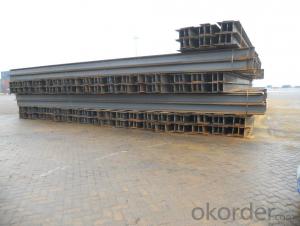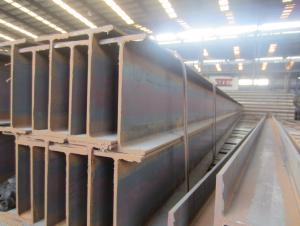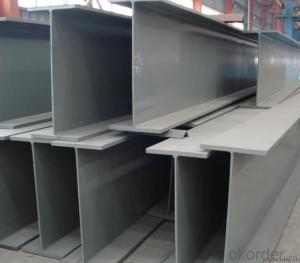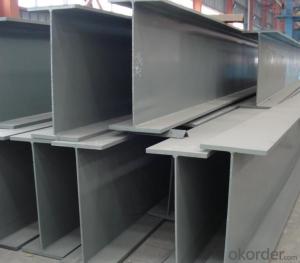Hot Rolled Steel H-Beam used for Prefabrication structure
- Loading Port:
- Tianjin
- Payment Terms:
- TT OR LC
- Min Order Qty:
- 10000 m.t.
- Supply Capability:
- 100000 m.t./month
OKorder Service Pledge
OKorder Financial Service
You Might Also Like
Item specifice
Product Description:
Product Description:
OKorder is offering Hot Rolled Steel H-Beam used for Prefabrication structure at great prices with worldwide shipping. Our supplier is a world-class manufacturer of steel, with our products utilized the world over. OKorder annually supplies products to European, North American and Asian markets. We provide quotations within 24 hours of receiving an inquiry and guarantee competitive prices.
Product Applications:
Hot Rolled Steel H-Beam used for Prefabrication structure are ideal for structural applications and are widely used in the construction of buildings and bridges, and the manufacturing, petrochemical, and transportation industries.
Product Advantages:
OKorder's Hot Rolled Steel H-Beam used for Prefabrication structure are durable, strong, and resist corrosion.
Main Product Features:
· Premium quality
· Prompt delivery & seaworthy packing (30 days after receiving deposit)
· Corrosion resistance
· Can be recycled and reused
· Mill test certification
· Professional Service
Product Specifications:
Specifications of Hot Rolled Steel H-Beam for Prefabrication structure
1. Standard: GB700-88, Q235B2.
2. Grade: Q235, SS400 or Equivalent
3. Length:10m, 12m as following table
4. Invoicing on theoretical weight or actual weight as customer request
5.Payment: TT or L/C
6. Sizes:
SIZE(mm) | DIMENSION(kg/m) |
150*150 | 31.1 |
148*100 | 20.7 |
198*99 | 17.8 |
200*100 | 20.9 |
248*124 | 25.1 |
250*125 | 29 |
Usage & Applications of Hot Rolled Steel H-Beam used for Structure Steel
Commercial building structure ;Pre-engineered buildings; Machinery support structure; Prefabricated structure; Medium scale bridges; Ship-building structure. etc.
Packaging & Delivery of Hot Rolled Steel H-Beam used for Prefabrication structure
1. Packing: it is nude packed in bundles by steel wire rod
2. Bundle weight: not more than 3.5MT for bulk vessel; less than 3 MT for container load
3. Marks:
Color marking: There will be color marking on both end of the bundle for the cargo delivered by bulk vessel. That makes it easily to distinguish at the destination port.
Tag mark: there will be tag mark tied up on the bundles. The information usually including supplier logo and name, product name, made in China, shipping marks and other information request by the customer.
If loading by container the marking is not needed, but we will prepare it as customer request.
4. Transportation: the goods are delivered by truck from mill to loading port, the maximum quantity can be loaded is around 40MTs by each truck. If the order quantity cannot reach the full truck loaded, the transportation cost per ton will be little higher than full load.
5. Delivered by container or bulk vessel
Production flow of Hot Rolled Steel H-Beam used for Prefabrication structure
Material prepare (billet) —heat up—rough rolling—precision rolling—cooling—packing—storage and transportation
FAQ:
Q1: Why buy Materials & Equipment from OKorder.com?
A1: All products offered byOKorder.com are carefully selected from China's most reliable manufacturing enterprises. Through its ISO certifications, OKorder.com adheres to the highest standards and a commitment to supply chain safety and customer satisfaction.
Q2: How do we guarantee the quality of our products?
A2: We have established an advanced quality management system which conducts strict quality tests at every step, from raw materials to the final product. At the same time, we provide extensive follow-up service assurances as required.
Images:
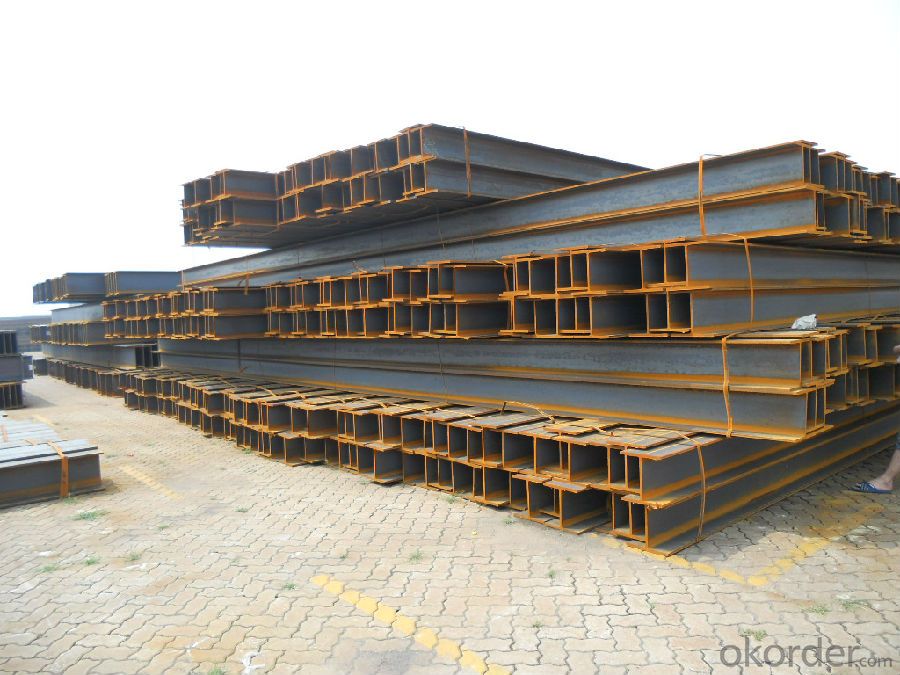
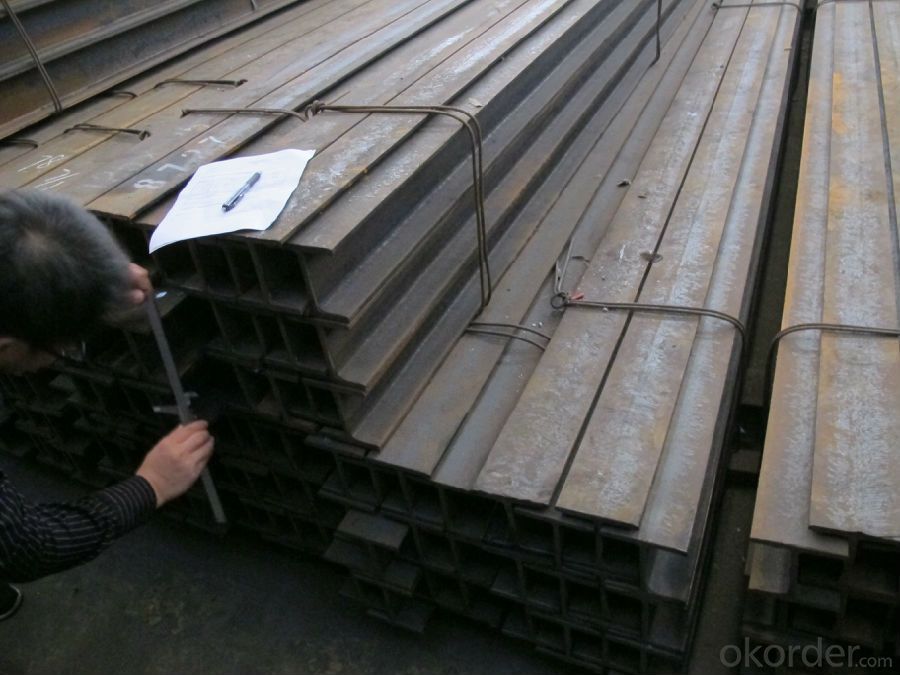

- Q:What are the design considerations for steel H-beams in high-rise buildings?
- When it comes to designing steel H-beams for high-rise buildings, it is crucial to take several important factors into consideration. These factors include: 1. Load-bearing capacity: The primary purpose of steel H-beams is to bear and transfer the weight of the building. Therefore, the design must guarantee that the beams have enough load-bearing capacity to support the structure's weight. This involves considering the dead load (building's weight), live load (occupant and equipment loads), and wind load. 2. Structural stability: High-rise buildings are exposed to various forces, such as wind, seismic activity, and temperature fluctuations. Consequently, the design of H-beams must ensure the building's structural stability by incorporating adequate bracing and connections that can withstand these forces and prevent any potential collapses. 3. Fire resistance: In the event of a fire, it is essential for steel H-beams to maintain their structural integrity for a specified period, allowing occupants to evacuate safely. To enhance the beams' fire resistance, fire-resistant coatings or fireproofing materials can be applied. 4. Deflection and vibration control: High-rise buildings are susceptible to deflection and vibrations caused by wind, earthquakes, and dynamic loads. The design must consider the maximum allowable deflection and vibration limits to ensure the comfort and safety of occupants. Measures such as increasing beam depth, adding stiffeners, or incorporating dampening devices can be implemented to control deflection and vibration. 5. Fabrication and construction considerations: The design of steel H-beams should also take into account ease of fabrication and construction. This involves designing the beams with standard sizes and lengths to facilitate efficient fabrication and erection processes. Moreover, the connections between beams should be designed to ensure ease of installation while maintaining structural integrity. 6. Sustainability: In modern high-rise buildings, it is crucial to incorporate sustainable design principles. Therefore, the design of steel H-beams should aim to minimize material consumption and waste, optimize energy efficiency, and maximize the use of recycled materials. All in all, the design considerations for steel H-beams in high-rise buildings encompass ensuring load-bearing capacity, structural stability, fire resistance, deflection and vibration control, ease of fabrication and construction, and sustainability. By meticulously addressing these considerations, engineers can create high-rise buildings that are both safe and efficient, while also being sustainable.
- Q:Can steel H-beams be used for industrial storage facilities?
- Yes, steel H-beams can be used for industrial storage facilities. Steel H-beams are commonly used in construction due to their strength and load-bearing capabilities. They provide structural support and can withstand heavy loads, making them suitable for industrial storage facilities where large quantities of materials or products need to be stored. Additionally, steel H-beams are durable and resistant to weathering, ensuring the longevity of the storage facility. They also offer versatility in terms of design and layout possibilities, allowing for efficient use of space and customization to meet specific storage needs. Overall, steel H-beams are a reliable and practical choice for constructing industrial storage facilities.
- Q:Are Steel H-Beams suitable for seismic retrofitting or strengthening of existing structures?
- Seismic retrofitting or strengthening of existing structures is indeed suitable for Steel H-Beams. Their exceptional strength-to-weight ratio is well-known, making them an optimal choice for enhancing the structural integrity of buildings in seismic zones. H-Beams offer remarkable load-bearing capacity and resilience against lateral forces, which are crucial factors in seismic events. They can effectively reinforce existing columns, beams, and other structural members, enabling them to withstand the additional forces generated during earthquakes. Moreover, the installation and integration of Steel H-Beams into existing structures are effortless, resulting in minimal disruption during retrofitting projects. All in all, the utilization of Steel H-Beams in seismic retrofitting is a proven and efficient method to enhance the overall safety and durability of buildings situated in earthquake-prone areas.
- Q:What are the different surface treatments available for steel H-beams?
- Steel H-beams have several surface treatment options, each with its own unique benefits and characteristics. The commonly used treatments are as follows: 1. Hot-dip galvanizing: To provide a durable and corrosion-resistant coating, the steel H-beam is immersed in molten zinc. This method is known for its excellent corrosion protection and is ideal for outdoor applications where the beams are exposed to moisture, chemicals, or harsh environments. 2. Powder coating: This dry finishing process involves applying a powdered polymer to the H-beam's surface using electrostatics. The coated beams are then cured under heat, resulting in a long-lasting and visually appealing finish. Powder coating offers corrosion resistance, impact resistance, UV protection, various color options, and the ability to achieve specific aesthetics. 3. Epoxy coating: A liquid protective coating, epoxy is applied and cured to form a hard, durable film. It provides outstanding adhesion, chemical resistance, and corrosion protection. Epoxy coatings are commonly used in industrial and marine applications where the beams face aggressive environments such as chemicals, saltwater, or high humidity. 4. Paint: Painting is a simple and cost-effective option where a layer of paint is applied to the H-beam surface. It creates a protective barrier against corrosion and enhances the appearance. Depending on specific requirements, various types of paint coatings, such as epoxy, polyurethane, or acrylic, can be used. 5. Metal plating: A thin layer of metal, such as chrome, nickel, or zinc, is deposited onto the steel H-beam surface. Metal plating offers improved corrosion resistance, enhanced appearance, and increased durability. It is suitable for decorative or high-end applications that require an attractive finish or protection against wear and tear. These examples highlight the available surface treatments for steel H-beams. The choice of treatment depends on factors such as the intended application, environmental conditions, desired aesthetics, and budget. It is crucial to carefully consider these factors and seek professional advice to determine the most suitable treatment for specific requirements.
- Q:What is the maximum length of a steel H-beam that can be manufactured?
- The maximum length of a steel H-beam that can be made depends on various factors, including the manufacturing process, transportation limitations, and practical constraints. Concerning the manufacturing process, steel H-beams are typically produced in set lengths, which can vary depending on the specific steel mill or manufacturer. These standard lengths typically range from 20 to 60 feet (6 to 18 meters). However, it is worth noting that longer lengths can often be requested or fabricated based on specific project requirements. Transportation restrictions also play a significant role in determining the maximum length of a steel H-beam. The beam's length must be able to fit within the constraints of transportation methods such as trucks, trains, or ships. Each of these transportation methods has its own size limitations, and going beyond these limits may necessitate special arrangements, permits, or even partial disassembly of the beam. Lastly, practical limitations must be considered when determining the maximum length of a steel H-beam. Lengthier beams can pose challenges in terms of handling, maneuvering, and installation at construction sites. The weight and size of the beam can make transportation and lifting more difficult, potentially requiring specialized equipment or additional manpower. In conclusion, while there are standard lengths for steel H-beams, the maximum length that can be manufactured is influenced by the manufacturing process, transportation restrictions, and practical considerations. Custom orders, transportation logistics, and practical limitations all contribute to determining the maximum length of a steel H-beam.
- Q:Can steel H-beams be used in the construction of commercial buildings or offices?
- Yes, steel H-beams can be used in the construction of commercial buildings or offices. H-beams are widely used in the construction industry due to their strength, durability, and load-bearing capabilities. They provide structural support and can withstand heavy loads, making them suitable for larger commercial buildings and office spaces. Additionally, steel H-beams are versatile and can be easily customized to meet the specific requirements of a construction project.
- Q:What are the different design codes for steel H-beams?
- There are various design codes that govern the use of steel H-beams in structural engineering. Some of the commonly used design codes for steel H-beams include: 1. American Institute of Steel Construction (AISC) - AISC provides design guidelines and specifications for steel H-beams in the United States. The AISC 360 "Specification for Structural Steel Buildings" is the primary design code used for steel H-beams in the US. It covers various aspects such as design principles, load combinations, structural detailing, and material properties. 2. Eurocode - Eurocode is a set of European standards for structural design. Eurocode 3, also known as EN 1993, provides design rules for steel structures, including H-beams. It covers topics such as material properties, cross-section classification, member design, and resistance to fire. 3. British Standards (BS) - The British Standards Institution (BSI) has developed several design codes for steel H-beams, such as BS 5950-1 for structural use of steelwork in buildings and BS EN 1993-1-1 for general structural design. 4. Canadian Standards Association (CSA) - CSA S16 is the main design code used for steel H-beams in Canada. It provides design principles, material specifications, and construction requirements for steel structures. 5. Australian Standards (AS) - In Australia, the design of steel H-beams is governed by AS 4100, which provides guidelines for structural design using steel. 6. International Building Code (IBC) - The IBC is a widely adopted building code in the United States. It references various design codes, including the AISC 360, for the design of steel structures, including H-beams. These are just a few examples of the design codes used internationally for steel H-beams. It is important for engineers and designers to follow the relevant code applicable to their region or project to ensure the safe and efficient design of steel H-beams.
- Q:What are the different joining techniques used for connecting steel H-beams?
- Some of the different joining techniques used for connecting steel H-beams include welding, bolting, and using adhesive bonding agents. Welding involves melting and fusing the steel beams together using heat, while bolting involves using bolts and nuts to fasten the beams together. Adhesive bonding agents, on the other hand, use specialized adhesives to bond the surfaces of the beams together. Each technique has its advantages and considerations depending on the specific application and requirements.
- Q:Are steel H-beams suitable for supporting transmission towers?
- Yes, steel H-beams are commonly used for supporting transmission towers. Steel H-beams offer several advantages that make them suitable for this purpose. Firstly, H-beams are structurally strong and have a high load-bearing capacity, which is essential for supporting the heavy weight and wind loads of transmission towers. Additionally, steel is a durable material that can withstand environmental factors such as corrosion and extreme weather conditions. Furthermore, steel H-beams can be easily fabricated and assembled, allowing for efficient construction of transmission towers. Overall, steel H-beams provide the necessary strength, durability, and ease of construction required for supporting transmission towers, making them a suitable choice for this application.
- Q:Can steel H-beams be used for curtain walls?
- Yes, steel H-beams can be used for curtain walls. Steel H-beams are commonly used in construction for their strength and durability. They provide excellent load-bearing capabilities, making them suitable for supporting curtain wall systems. Curtain walls are non-structural, lightweight, and typically made of glass or other materials. The H-beams can be used as the primary structural support for the curtain wall, allowing for large, open areas of glazing while ensuring stability and safety. Additionally, steel H-beams can be customized to meet the specific design requirements of the curtain wall system, making them a versatile choice for this application.
1. Manufacturer Overview |
|
|---|---|
| Location | |
| Year Established | |
| Annual Output Value | |
| Main Markets | |
| Company Certifications | |
2. Manufacturer Certificates |
|
|---|---|
| a) Certification Name | |
| Range | |
| Reference | |
| Validity Period | |
3. Manufacturer Capability |
|
|---|---|
| a)Trade Capacity | |
| Nearest Port | |
| Export Percentage | |
| No.of Employees in Trade Department | |
| Language Spoken: | |
| b)Factory Information | |
| Factory Size: | |
| No. of Production Lines | |
| Contract Manufacturing | |
| Product Price Range | |
Send your message to us
Hot Rolled Steel H-Beam used for Prefabrication structure
- Loading Port:
- Tianjin
- Payment Terms:
- TT OR LC
- Min Order Qty:
- 10000 m.t.
- Supply Capability:
- 100000 m.t./month
OKorder Service Pledge
OKorder Financial Service
Similar products
New products
Hot products
Related keywords
